
Binary Fission: Prokaryote Cells
In lesson three you learned by cells reproduce asexually by mitosis. This lesson will concern itself with the mechanism primitive cells use for replication. Read the pages indicated by G-8 and study behavioral objectives 17 and 18. All eukaryote cells (fungi, protists, plants and animals) reproduce asexually at the cellular level by mitosis as previously described. Prokaryotic cells (bacteria and blue -green algae) and viruses reproduce by binary fission. During binary fission in prokaryote cells the single circular DNA replicates and the cell divides with each cell receiving one of the single circular DNA molecules.
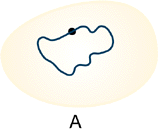
Figure A represents a bacterium cell with a single
circular DNA molecule containing all of its genes. Note:
no nuclear membrane, chromatin or nucleoli.
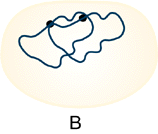
Figure B represents a the bacterium cell after DNA
replication. This process will be described in miniunit Delta..
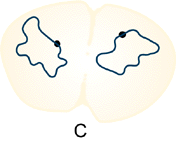
Figure C represents a bacterium cell after
the two circular DNA molecules separate and the cell membrane begins to
pinch the cytoplasm into two parts.
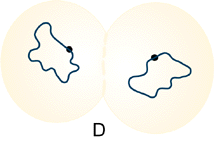
Figure D represents continuous pinching the
cytoplasm into two cells.
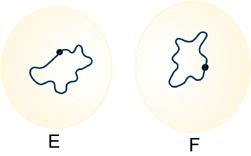
Figures E and F represent two complete bacteria
cells after binary fission. These two cells are genetically alike.
Viral Replication
Viruses reproduce similar to the bacteria except
the DNA must first be injected into a living cell (prokaryote or eukaryote)
where the DNA replicates and than forms more viruses inside the living
cell. Read the pages indicated by G-8 concerning viral replication. Learn
the following steps concerning virus reproduction. (1) virus enters
a cell by endocytosis, (2) virus DNA enters the nucleus, (3) viral DNA
is copied many times (4) virus DNA is transcribed into mRNA which moves
to cytoplasm (5) mRNA makes various virus parts (6) viruses are assembled
into many complete viruses. (7) newly formed viruses leave the cell by
exocytosis or destroying the living cell. Viruses may also
have its DNA incorporated into the host chromosomes. The host cell may
replicate by mitosis forming many cells with the viral incorporated DNA.
At a later time the viral genes may be transcribed into mRNA which produces
more viruses. In your notes write the differences between a virus
and a bacteriophage. Draw two figures in your notes showing
bacteria and viral replication.
Bacteriophage:
1. Viruses reproduce by binary fission outside of of living cells.
a) true b) false
Press here to check answer. press
2. Viruses will only attack only eukaryotic cells.
a) true b) false
Press here to check answer. press
The correct answer to the question below will move you to the
next page.
3. Identify the statements below to one of the following processes:
A) mitosis B) bacteria reproduction C) viral replication D) all three processes
1. Genes segregated via DNA replication and
segregation.
2. Consists of spindle fibers which pull chromosomes
to opposite poles.
3. DNA must be replicated many times in a living
host cell before forming new
organisms.
4. DNA replicates followed by the cell pinching
the cytoplasm into two cells each
of which contains one of
the DNA molecules.
1 2 3 4
a)
C
D
A
B
b)
A
B
D
C
c)
D
A
C
B
d)
D
C
A
B
For information on how to use this page, go to How
to Use This Site.
Created by the Center for Learning Technologies, Academic Technology Services.
Last modified October 22, 1997.